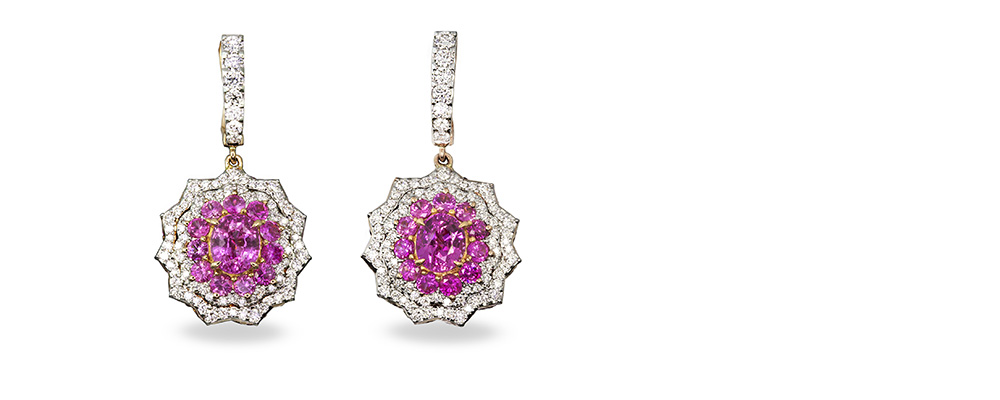A discussion of DRIFTS vs the Beam Condenser FTIR attachment in the testing of pink sapphire. The DRIFTS accessory is generally much better at unmasking heat treatment in ruby and sapphire.
FTIR in Gem Testing • A Pink Sapphire Lesson
In January 2020, a pair of earrings were brought to Lotus Gemology's Bangkok lab for testing. We were asked to test the pink sapphire at the center of each earring (Figure 1).
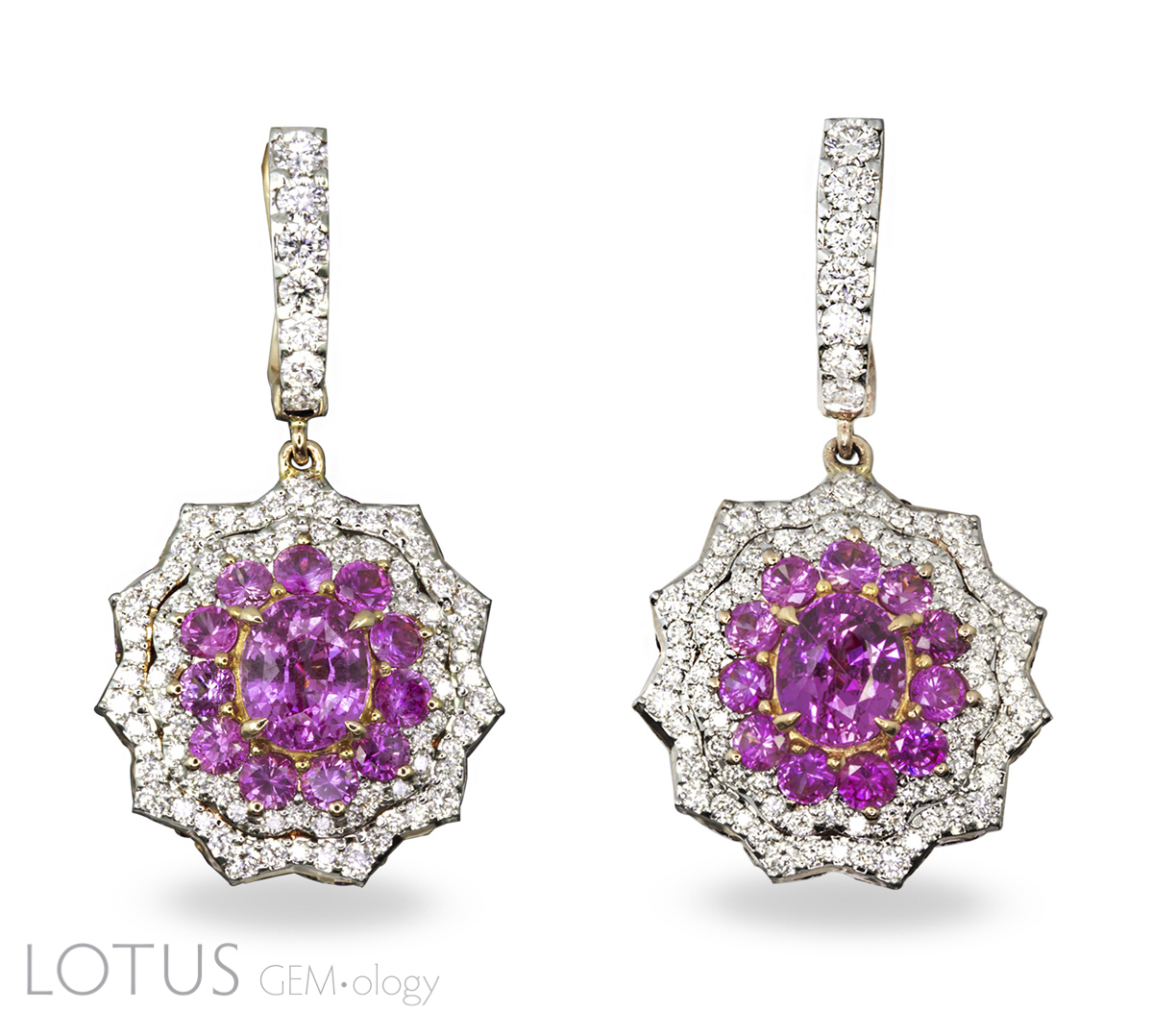 Figure 1. The pink sapphire earrings that are the subject of this article. While the stone at left showed clear evidence of heat treatment, the right earring did not. As a result, we asked the client to unmount the stone. Photo: Wimon Manorotkul; earrings courtesy of VPGemstones Co., Ltd., Bangkok
Figure 1. The pink sapphire earrings that are the subject of this article. While the stone at left showed clear evidence of heat treatment, the right earring did not. As a result, we asked the client to unmount the stone. Photo: Wimon Manorotkul; earrings courtesy of VPGemstones Co., Ltd., Bangkok
The first gem tested showed inclusion evidence suggesting it had been subjected to heat treatment. But in the second gem, the inclusion evidence was inconclusive and partially obscured by the mounting.
Under the normal testing protocol at Lotus Gemology, all corundums will have their infrared spectra measured using a Bruker Tensor 27 FTIR unit with a Pike EasyDiff™ diffused reflectance (DRIFTS) collection device.
Due to the mounting, we were forced to use a Pike 4x beam condenser attachment to measure the infrared spectrum. The result was the spectrum shown in Figure 2.
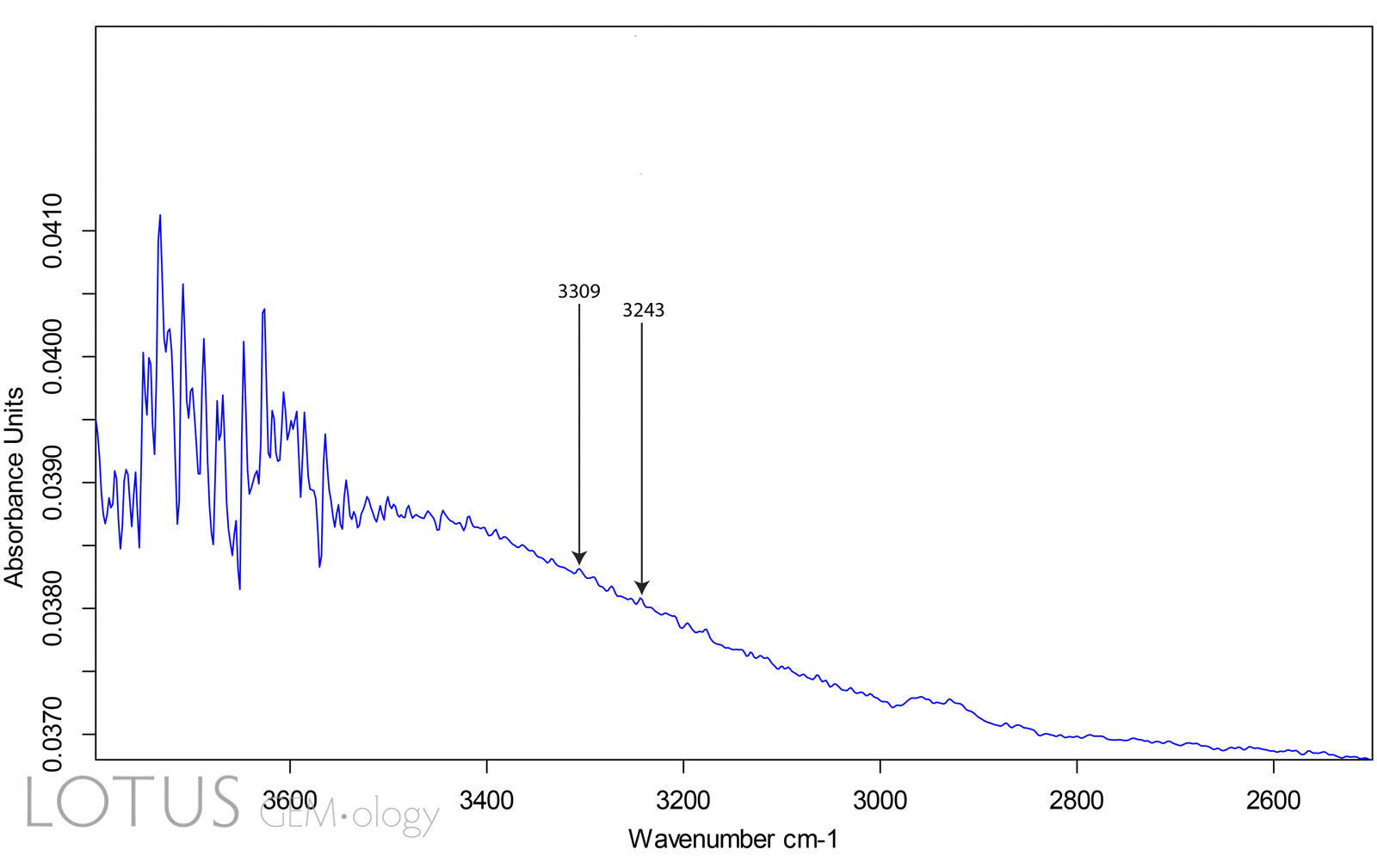 Figure 2. Infrared spectrum of a Madagascar pink sapphire using the Pike 4x beam condenser collection attachment. This sends a narrow beam through the gem. Using this technique, the 3309 cm-1 was at the noise floor, while the 3232 cm-1 peak was not visible at all.
Figure 2. Infrared spectrum of a Madagascar pink sapphire using the Pike 4x beam condenser collection attachment. This sends a narrow beam through the gem. Using this technique, the 3309 cm-1 was at the noise floor, while the 3232 cm-1 peak was not visible at all.
Because the inclusion and spectral evidence was inconclusive regarding heat treatment, we requested that the client unmount the stone. After unmounting, we again measured the infrared spectrum, this time using the DRIFTS attachment. The resulting spectrum is shown in Figure 3, where both the 3309 cm-1 and key peak at 3232 cm-1 rise above the noise floor. This clearly demonstrates why DRIFTS is the better choice for measuring the infrared spectra of most gems.
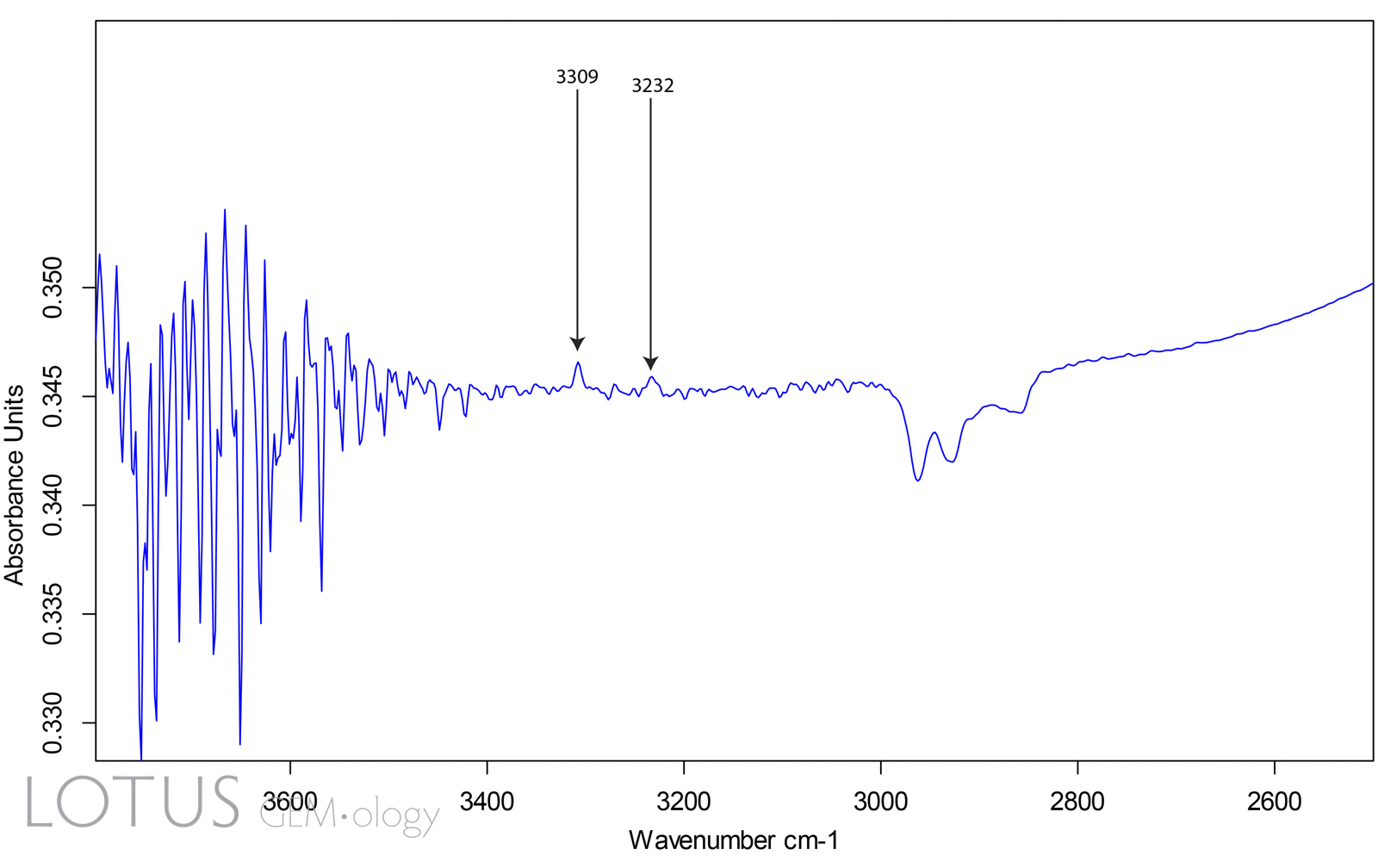 Figure 3. Infrared spectrum of the same Madagascar pink sapphire using the DRIFTS (diffuse reflectance) attachment. This bounces the beam through the gem from a variety of directions. Using this technique, the 3309 cm-1 rises well above the noise floor. In addition, the peak at 3232 cm-1 rises above the noise floor, proving that the gem had been subjected to artificial heat treatment.
Figure 3. Infrared spectrum of the same Madagascar pink sapphire using the DRIFTS (diffuse reflectance) attachment. This bounces the beam through the gem from a variety of directions. Using this technique, the 3309 cm-1 rises well above the noise floor. In addition, the peak at 3232 cm-1 rises above the noise floor, proving that the gem had been subjected to artificial heat treatment.
Discussion
Over the years, gemologists have measured the infrared spectra of tens of thousands of rubies and sapphires. The appearance of a peak at 3232 cm-1 has proven to be an extremely strong indicator of heat treatment (Atichat et al., 2011). Crystals by definition display directional properties, and their spectra are no exception. Because the DRIFTS attachment samples light moving through the gem in a variety of directions, it is more likely to reveal information such as the key 3232 cm-1 peak (Hughes et al., 2007). Thus, it should be the first choice for gemologists measuring infrared spectra.
The basalt caveat
It is important to note that when using the infrared spectrum as a tool to unmask heat treatment, caution should be taken when the ruby or sapphire is believed to have been produced from a magmatic source such as a basalt. In both ruby and sapphire from basaltic sources, while the gems may have formed deeper in the ground through metamorphic processes, they are transported to the surface in volcanic rocks such as basalts. The heat from these volcanic rocks can produce inclusions, UV fluorescence and spectral features in the infrared that closely resemble stones that have been artificially heat treated (Figure 4). This includes the important 3232 cm-1 peak (Soonthorntanikul et al., 2019).
Basalt-related sapphires come from around the world, including Australia, Cambodia, Cameroon, China, Ethiopia, France, Kenya, Laos, Madagascar (far north), Nigeria, Rwanda, Scotland, Thailand and Vietnam.
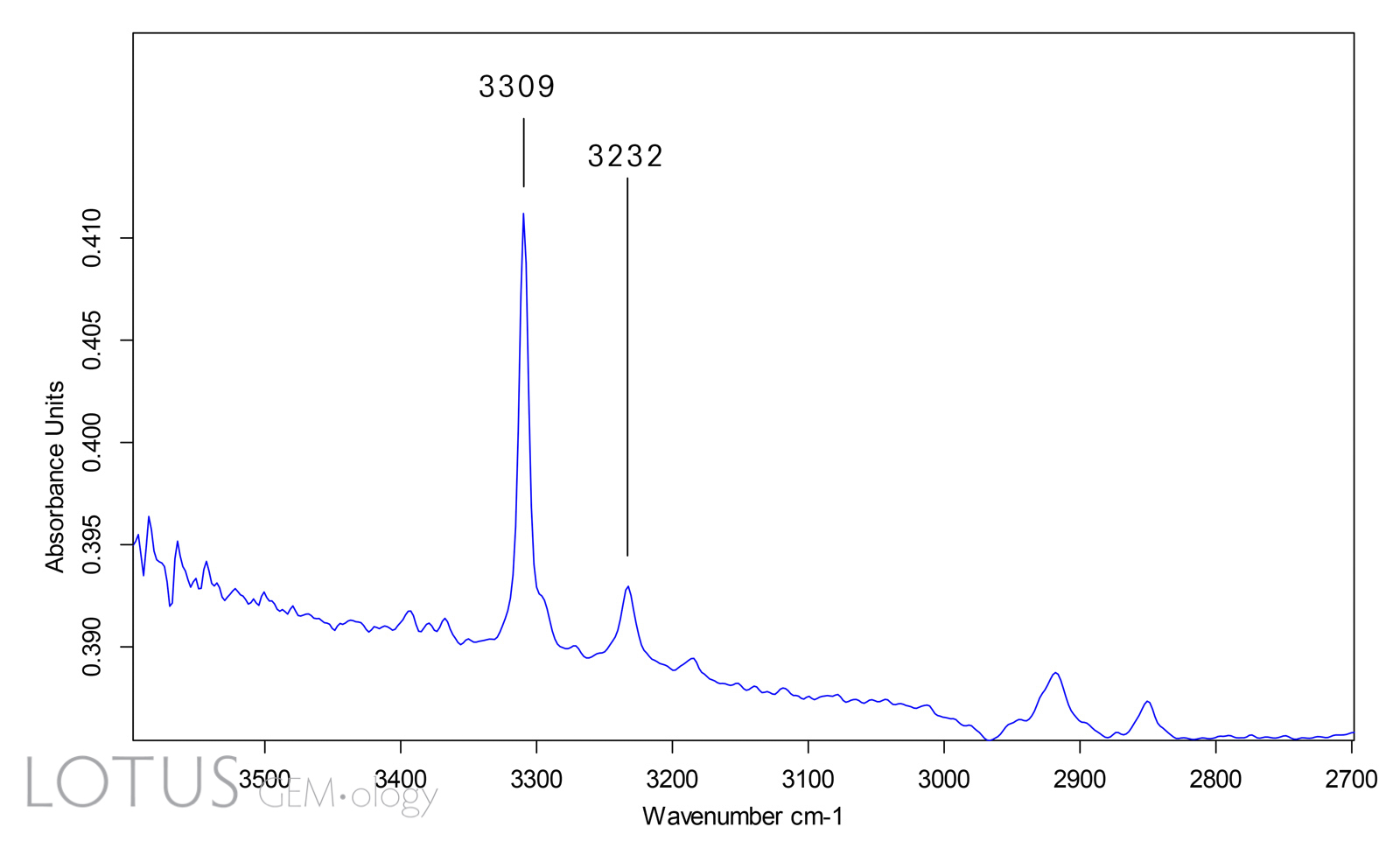 Figure 4. Due to the heat of the magma that brought them to the surface, basalt-related corundums may show the 3232 peak even without being artificially heat treated.
Figure 4. Due to the heat of the magma that brought them to the surface, basalt-related corundums may show the 3232 peak even without being artificially heat treated.
Conclusion
The FTIR spectrum has proven to be an essential technique in unmasking heat treatment in both ruby and sapphire. But like any tool, it requires a skilled operator to extract its full potential. Part of that skill is the choice of the collection device (DRIFTS vs. beam condenser). In addition, it is crucial that clients be warned about the perils of testing gems while mounted. Mountings severely restrict the types of tests that can be performed, as well as the information gathered by those tests. All gems tested by Lotus Gemology in the mounted state feature the following warning on the report: "Mounted gems are tested only to the degree permitted by the mounting. Results may change following unmounting."

References
- Atichat, W., Leelawatanasuk, T., Sriprasert, B., Pisutha-Arnond, V., Wathanakul, P. and Suthirat, C. (2011) Mozambique ruby: Indication of low-temperature heat treatment. 32nd International Gemmological Conference, Interlaken, Switzerland, pp. 157–159; RWHL.
- Hughes, R.W., Castoro, L., Nyunt, H-P. K. & Kiefert, L. (2007) FTIR in Gem Testing • FTIR Intrigue. LotusGemology.com; accessed 13 Feb. 2020.
- Soonthorntanikul, W., Khowpong, C., Atikarnsakul, U., Saeseaw, S., Sangsawong, S., Vertriest, W. and Palke, A. (2019) Observations on the heat treatment of basalt-related blue sapphires. Gemological Institute of America, no city, 60 pp.; RWHL*.
About the Authors
Richard W. Hughes is one of the world’s foremost experts on ruby and sapphire. The author of several books and over 170 articles, his writings and photographs have appeared in a diverse range of publications, and he has received numerous industry awards. Co-winner of the 2004 Edward J. Gübelin Most Valuable Article Award from Gems & Gemology magazine, the following year he was awarded a Richard T. Liddicoat Journalism Award from the American Gem Society. In 2010, he received the Antonio C. Bonanno Award for Excellence in Gemology from the Accredited Gemologists Association. The Association Française de Gemmologie (AFG) in 2013 named Richard as one of the Fifty most important figures that have shaped the history of gems since antiquity. In 2016, Richard was awarded a visiting professorship at Shanghai's Tongji University. 2017 saw the publication of Richard and his wife and daughter's Ruby & Sapphire • A Gemologist's Guide, arguably the most complete book ever published on a single gem species and the culmination of nearly four decades of work in gemology. In 2018, Richard was named Photographer of the Year by the Gem-A, recognizing his photo of a jade-trading market in China, while in 2020, he was elected to the board of directors of the Accredited Gemologists Association and was appointed to the editorial review board of Gems & Gemology and The Australian Gemmologist magazine. Richard's latest book, Jade • A Gemologist's Guide, was published in 2022.
Wimon Manorotkul has been involved with gems and gemology since 1979, as a lab gemologist, instructor and photographer. She is an Accredited Gemologist from Bangkok's Asian Institute of Gemological Sciences and for many years directed their lab. Wimon also qualified as a Fellow (with honors) of the Gemmological Association of Great Britain. A skilled gem photographer, her images have been featured in books and magazines around the world, particularly Ruby & Sapphire: A Collector's Guide, along with Ruby & Sapphire: A Gemologist's Guide and Inside Out | GEM• ology Through Lotus-Colored Glasses. Wimon not only photographs gems, jewelry and mineral specimens, but is also an expert photomicrographer. In 2013, she founded Lotus Gemology with her husband, Richard Hughes, and daughter, E. Billie Hughes.
Notes
First published in the The Journal of the Gemmological Association of Hong Kong, 2020, Vol. 41, pp. 61–63.

